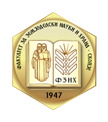TOTAL ANTHOCYANINS IN FRESH FRUIT AND COMPOTE OF "OBLACINSKA" SOUR CHERRY (PRUNUS CERASUS L.)
Keywords:
anthocyanins, sour cherry, compote, spectrophotometry.Abstract
Anthocyanins are secondary metabolites of plants in the flavonoid family. Red and blue fruits are the main sources of anthocyanins, because cyanidin-3-glucoside is one of the most common and gives the red colour of the fruit. They are soluble in water and are 100 % absorbed by the human body. Anthocyanins are powerful antioxidants that protect our body from free radicals. They have a unique ability to resist ultraviolet light and reduce the risk of serious illness. Nutritionists recommend the use of anthocyanins in amounts of 10 to 15 mg per day. Sour cherry (Prunus cerasus L.) contains high levels of anthocyanins that have strong antioxidant and anti-inflammatory properties. In this paper, for the determination of the content of total anthocyanins, fresh fruits from the sour cherry "Oblacinska" variety and compotes of the same variety sweetened with sucrose and stevia are used. Anthocyanins are examined according to the following method: AOAC Official Method 2005.02, Total Monomeric Anthocyanin Pigment Content of Fruit Juices, Beverages, Natural Colorants, and Wines, pH Differential Method. The content of anthocyanins is in the following order: 32.00 mg cyanidin-3-glucoside equivalents / 100 g in fresh sour cherry fruits, 16.10 mg cyanidin-3-glucoside equivalents / 100 g in sour cherry compote with sucrose and 16.12 mg cyanidin-3-glucoside equivalents / 100 g in sour cherry compote with stevia.



